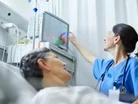Digitisation in hospitals: what it means for monitoring

The COVID-19 pandemic has almost brought the healthcare system in certain countries to collapse and once again made it clear how necessary comprehensive modernisation and digitisation are. The much-vaunted improvement in working conditions for doctors and nursing staff also requires a functioning and efficient infrastructure. But successful digitisation can only take place if IT and medical infrastructures collaborate smoothly. What role does monitoring play in a hospital setting, and what can it do?
Why use monitoring in hospitals?
In principle, monitoring already takes place in hospitals: IT components such as storage systems, networks or servers are naturally monitored. Modern medical devices and systems also provide native options for monitoring functions. What is missing is a central overview of the big picture.
Let’s take an IT manager from a large hospital as an example: his team spends a great deal of time and effort building a dashboard that displays the status of all medical components. To do this, all individual medical components have been individually integrated into the dashboard with their respective native monitoring tool. IT monitoring is done independently with an IT monitoring solution that provides its dashboards separate from the medical infrastructure. The hospital also used a central communications server, but it isn’t integrated into the monitoring. This requires a lot of effort, without a central overview of the IT and medical technology.
Now, if a doctor has problems accessing X-ray images at the patient's bedside, he might first call the X-ray station. They can then tell him whether the X-ray machine is working. It is more likely that another department is involved, probably IT. So the doctor calls IT and they check the PACS and then report that that's not where the error is. Then IT continues troubleshooting and checks the communication server. Then they check the IT systems such as databases, storage systems, servers, network, and WLAN. By the time the error is finally identified and corrected, various departments and numerous individual systems in the departments are involved. Now the missing X-ray image is not an emergency. It’s annoying, but not critical. However, it is often a matter of life and death in a hospital, and every minute counts. Central monitoring not only makes everyday life much easier, but it can also save precious time in emergencies.
What else needs to be considered when choosing a monitoring solution?
Here are a few factors that apply to more or less just about every hospital:
Lack of time
A suitable monitoring solution can save a lot of time - through timely alerting as well as in error identification. Every monitoring solution requires a certain amount of effort for implementation and maintenance. However, there are big differences between the various solutions. Here, it is important to consider both the effort required for implementation and daily operation when evaluating.
- Is a competent service provider available?
- Does the manufacturer provide reliable support?
- Can the solution be tested easily and without obligation in advance?
Tight budgets
Budgets are usually tight in the healthcare sector. In addition to preventing damage from outages and performance losses, monitoring can play an important role in helping hospitals save money: long-term monitoring helps to optimise IT infrastructures, whether that’s through virtualisation measures or the more needs-based provision of hardware and other resources.
That’s when it is important not only to keep an eye on the license costs of the solution, but also on the costs for implementation, maintenance, and, if necessary, extensions. This is not only about costs in the form of invoices, but also about the effort and time that have to be invested.
Stress
The shortage of personnel leads to a heavy workload for IT team members. Stress is the result - and as a consequence of stress, errors creep in, tasks are neglected and unnecessary costs are incurred. A monitoring solution for an entire hospital unifies the application landscape. Fewer different tools make the daily routine of IT experts clearer and less stressful. And of course, comprehensive monitoring with intelligent alerting helps relieve the burden on the entire team.
A solution for complete monitoring helps to avoid stress in many ways. To do this, however, the solution must be easy to use and, above all, offer the possibility of clearly preparing the right information for the right people, alerting the relevant people in a targeted manner, and using escalation mechanisms to ensure that no alarm goes unnoticed.
What solutions are suitable for monitoring in hospitals?
To centrally monitor both IT and medical devices and systems in a hospital, the monitoring solution must meet a whole range of requirements. Usually, this will be a solution recommended by IT, the reasons for this are obvious:
- Many IT monitoring solutions are vendor-independent and designed for a wide range of functions. They offer comprehensive display, alerting and reporting options and are often standardised, meaning that the effort required for implementation and operation is manageable. This broad approach to monitoring is not very common in medicine. Here, there are usually only native monitoring tools from the respective device manufacturers. Only the communications servers offer an equivalent here, but they are not designed for monitoring.
- While two protocols are essentially relevant in healthcare (HL7 and DICOM), IT is much more complex. This means that "teaching IT" to an existing hospital monitoring solution would be much more complex than "teaching hospital" to an IT monitoring solution.
It can be said that broad-based IT monitoring solutions offer the best prerequisites for comprehensive monitoring in hospitals. It is important that the chosen monitoring solution cannot access patient data directly, but can only record the status of the devices or information about the transport and storage of the data. In this way, you are on the safe side as far as the very sensitive data protection rules in the medical sector are concerned.



